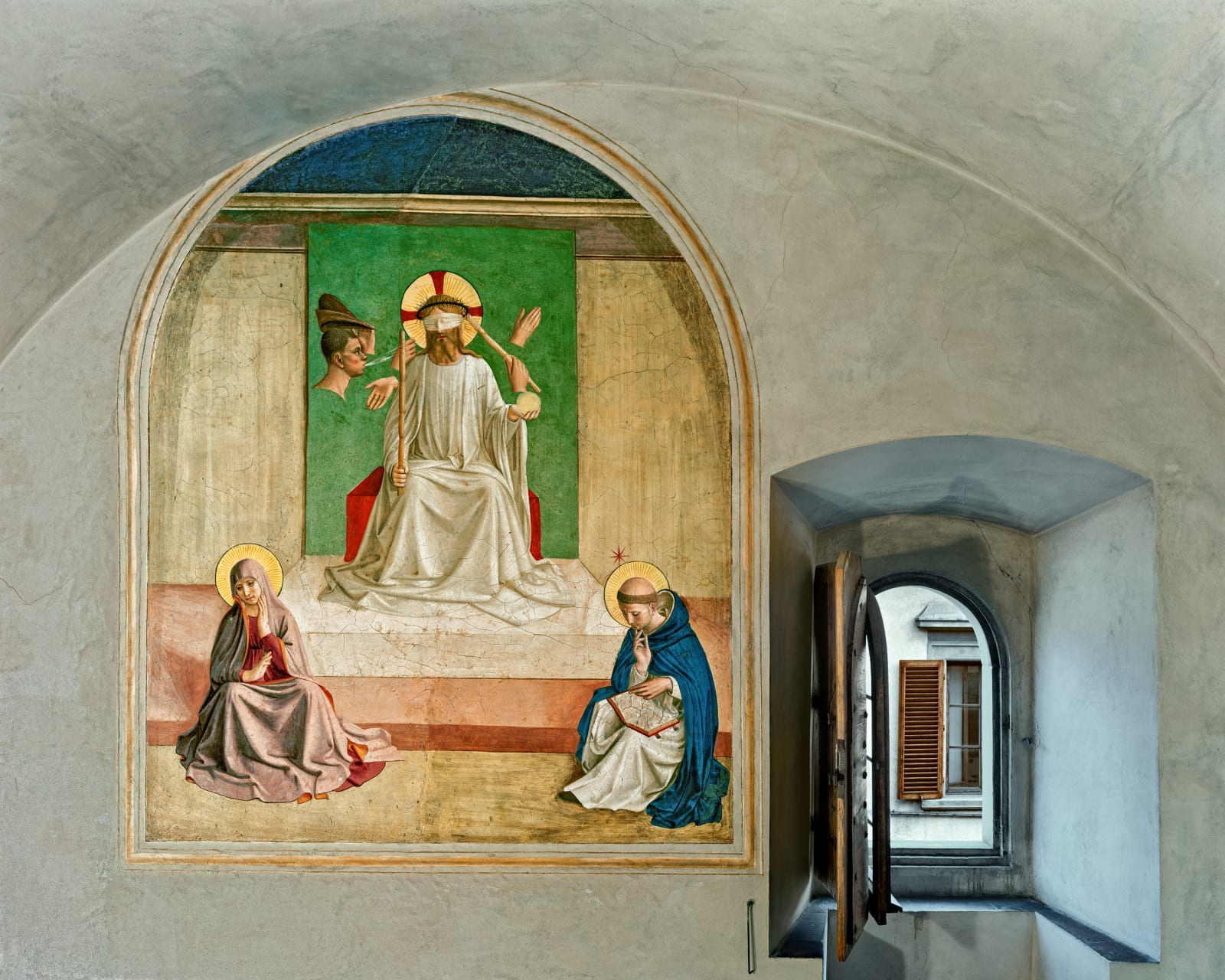
Robert Polidori
The Mocking of Christ by Fra Angelico, Cell 7, Museum of San Marco Convent, Florence, Italy, 2010
archival pigment print mounted to dibond
44 x 54 inches
111.8 x 137.2 cm
111.8 x 137.2 cm
Edition of 5 + 2 APs
Senior Friars Cells (Cells 1-11) Cell 7 featured in the present work ‘And they stripped him, and put on him a scarlet robe. And when they had platted a crown...
Senior Friars Cells (Cells 1-11)
Cell 7 featured in the present work
‘And they stripped him, and put on him a scarlet robe. And when they had platted a crown of thorns, they put it upon his head, and a reed in his right hand: and they bowed the knee before him, and mocked him, saying, Hail, King of the Jews! And they spit upon him, and took the reed, and smote him on the head.’ (Matthew. 27:28-30)
The soldiers have placed the beaten and despised figure of Christ on a makeshift throne, over which, in derision, they have placed a regal purple cloth, painted in flaming red ochre. Here, Christ receives and patiently bears the blows, the insolence, and mockery, in the same way as the just man described in David’s messianic psalm; through infinite love he relives the infamy and abjection that the ignorant populace reserve for the humble and poor. (Psalm. 22:7,24)
The painter deemed the soldiers too coarse to be included, and only their offensive or mocking gestures are shown: several hands, a rod, and a jet of spit emerging from a brutish face are depicted around Christ’s head. Using the tradition of Imagines Pietatis, in which the instruments of the Passion are symbolically represented, Fra Angelico creates a new and immediate synthesis, a tightly woven vortex rather than a complete, catalog-like display: the events described in succession in the Gospels occur synchronously. Fra Angelico increases the imaginative power of the fresco by using more than one source. To Matthew’s account, which is almost exactly repeated by Mark (15:16-19), he adds the blow recounted by John (19:2-3). The purple robe which the soldiers placed on Christ’s shoulders is transformed into the red cloth on the pseudo-throne.
The aim of the painter was to represent, using the most simple expressive means, the humiliation of divine majesty wrought by the ignorance of men. In the lower register of the fresco, the Virgin Mary and St Dominic sit absorbed in meditation beside the throne. Neither figure looks at the object of their love, but both reflect on the subject of the vilified Messiah. St Dominic’s study of the Holy Scriptures to find the truth contained in the mystery of the abused and derided Son of God is upheld and illuminated by the by the presence of the Messiah.
P. Morachiello, Fra Angelico The San Marco Frescoes, 1996, p. 106.
Cell 7 featured in the present work
‘And they stripped him, and put on him a scarlet robe. And when they had platted a crown of thorns, they put it upon his head, and a reed in his right hand: and they bowed the knee before him, and mocked him, saying, Hail, King of the Jews! And they spit upon him, and took the reed, and smote him on the head.’ (Matthew. 27:28-30)
The soldiers have placed the beaten and despised figure of Christ on a makeshift throne, over which, in derision, they have placed a regal purple cloth, painted in flaming red ochre. Here, Christ receives and patiently bears the blows, the insolence, and mockery, in the same way as the just man described in David’s messianic psalm; through infinite love he relives the infamy and abjection that the ignorant populace reserve for the humble and poor. (Psalm. 22:7,24)
The painter deemed the soldiers too coarse to be included, and only their offensive or mocking gestures are shown: several hands, a rod, and a jet of spit emerging from a brutish face are depicted around Christ’s head. Using the tradition of Imagines Pietatis, in which the instruments of the Passion are symbolically represented, Fra Angelico creates a new and immediate synthesis, a tightly woven vortex rather than a complete, catalog-like display: the events described in succession in the Gospels occur synchronously. Fra Angelico increases the imaginative power of the fresco by using more than one source. To Matthew’s account, which is almost exactly repeated by Mark (15:16-19), he adds the blow recounted by John (19:2-3). The purple robe which the soldiers placed on Christ’s shoulders is transformed into the red cloth on the pseudo-throne.
The aim of the painter was to represent, using the most simple expressive means, the humiliation of divine majesty wrought by the ignorance of men. In the lower register of the fresco, the Virgin Mary and St Dominic sit absorbed in meditation beside the throne. Neither figure looks at the object of their love, but both reflect on the subject of the vilified Messiah. St Dominic’s study of the Holy Scriptures to find the truth contained in the mystery of the abused and derided Son of God is upheld and illuminated by the by the presence of the Messiah.
P. Morachiello, Fra Angelico The San Marco Frescoes, 1996, p. 106.
